May 27, 2013
Palaces—the ideal way to celebrate your birthday in Istanbul
If it’s your birthday (and we celebrated two in Istanbul today), you might consider going to palaces, as we did.
The first palace is what you’d think of as a palace—the Topkapi Palace of 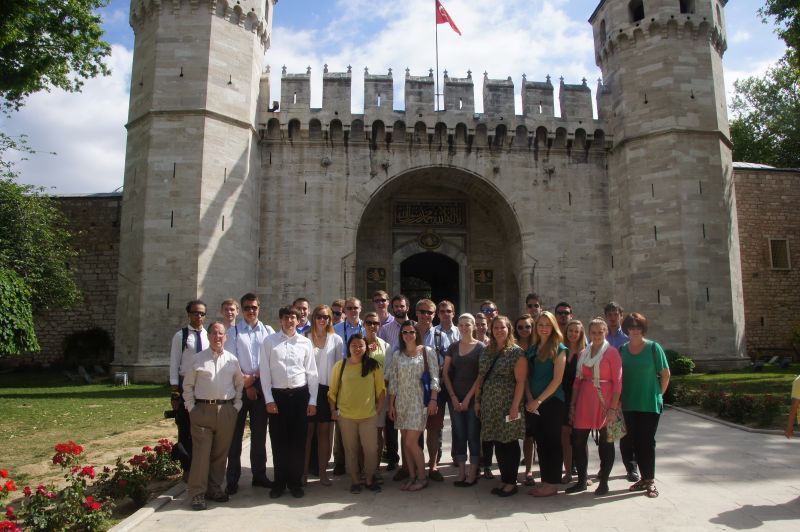 the 36 Sultans of the Ottoman Empire (1453-1923, though the family moved in the late 18th century to a more European palace in another part of the city). Having been to Windsor Castle, Versailles, and Potsdam, we’ve seen Western European castles and palaces. No one, however, except me, had seen the palaces in India (the Moghul forts at New Delhi and Agra) that are the closest equivalent of Topkapi—with the open pavilions, the gold and tile floral decorations—etc., that make me think of Scheherazade).
the 36 Sultans of the Ottoman Empire (1453-1923, though the family moved in the late 18th century to a more European palace in another part of the city). Having been to Windsor Castle, Versailles, and Potsdam, we’ve seen Western European castles and palaces. No one, however, except me, had seen the palaces in India (the Moghul forts at New Delhi and Agra) that are the closest equivalent of Topkapi—with the open pavilions, the gold and tile floral decorations—etc., that make me think of Scheherazade).
Inside, the treasuries and the sacred relics remind one that Turkey, called the “sick man of Europe” in the late 19th and early 20th centuries, was quite healthy, wealthy, and wise earlier. The treasury (and here there is a connection with the Moghul empire I referred to earlier) has a number of 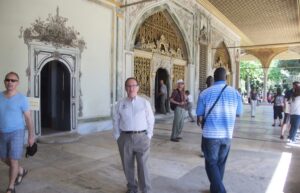 artefacts that are stunning—diamonds, jade, jewels—and the Peacock throne, which a Persian army looted from New Delhi, and the Ottomans took from Persia. The religious relics included the sword of David, the staff of Moses, an arm and jawbone of St. John the Baptist—and hair from the beard of Mohammed, his footsteps, his sword—all reminders that at one time, the Ottomans conquered the Holy Lands (Mecca and Jerusalem), and the Caliphate was in effect the “pope” of the Muslim world. I think one of the many titles of the sultan was Defender of the Faith. Expanded over the years, Topkapi became the second largest palace complex over the years—second to the Forbidden City. Ataturk turned it into a museum in the 1920s.
artefacts that are stunning—diamonds, jade, jewels—and the Peacock throne, which a Persian army looted from New Delhi, and the Ottomans took from Persia. The religious relics included the sword of David, the staff of Moses, an arm and jawbone of St. John the Baptist—and hair from the beard of Mohammed, his footsteps, his sword—all reminders that at one time, the Ottomans conquered the Holy Lands (Mecca and Jerusalem), and the Caliphate was in effect the “pope” of the Muslim world. I think one of the many titles of the sultan was Defender of the Faith. Expanded over the years, Topkapi became the second largest palace complex over the years—second to the Forbidden City. Ataturk turned it into a museum in the 1920s.
The second “palace” was the executive suite of the Nurol Company, an investment/ banking/tourism real estate/defense business, and the  executive suite—with its paneled boardroom, library, dining room, and full bar was fit for a padishah (although probably not the bar).
executive suite—with its paneled boardroom, library, dining room, and full bar was fit for a padishah (although probably not the bar).
Three executives introduced us to the company and its activities, and pointed out that the Turkish population is young (over 50% under 21), and doing well economically. The banking crisis occurred in 1999-2001, so when the economy tanked in 2008 elsewhere, Turkish banks had already restructured and were well regulated. Personally, they said, Turks were eager to join the EU—before 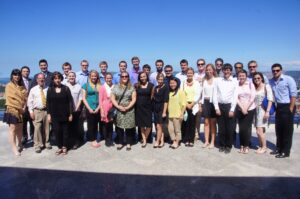 2008—but now are not so sure. The company itself has numerous projects and holdings, few of them in Europe, and most of them trading regionally (Russia and the nation of Georgia) or Muslim countries, like the UAE, Algeria, and Malaysia.
2008—but now are not so sure. The company itself has numerous projects and holdings, few of them in Europe, and most of them trading regionally (Russia and the nation of Georgia) or Muslim countries, like the UAE, Algeria, and Malaysia.
The third “palace” was the Chora Church, renowned for its mosaics and frescoes. It was certainly high on my list of “must sees” in Istanbul. 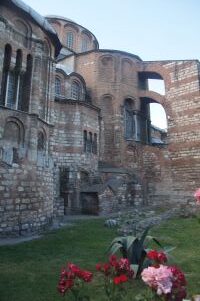
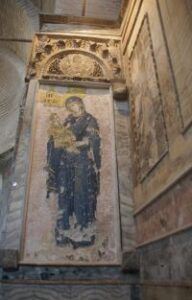 Located now inside the Justinian Walls that held off invaders (including the Mongol army) until 1453, the church was once outside the walls, which is the meaning of Chora. Converted to a mosque after the Ottoman conquest, the Muslims plastered over the Christian designs until (again) the Republic turned the mosque into a museum and re-revealed the original mosaics.
Located now inside the Justinian Walls that held off invaders (including the Mongol army) until 1453, the church was once outside the walls, which is the meaning of Chora. Converted to a mosque after the Ottoman conquest, the Muslims plastered over the Christian designs until (again) the Republic turned the mosque into a museum and re-revealed the original mosaics. 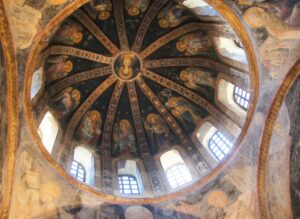 The ceilings are literally covered with the story of Jesus and Mary, the gift of a city official in the 14th century, which saw a renaissance (our guide used the word, and said that the “Renaissance” began in Byzantium before it spread to Western
The ceilings are literally covered with the story of Jesus and Mary, the gift of a city official in the 14th century, which saw a renaissance (our guide used the word, and said that the “Renaissance” began in Byzantium before it spread to Western 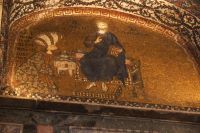 Europe) of culture in what was after 1261 a very truncated (and besieged) Empire. We spent about an hour on a tour of one of the best preserved Byzantine Churches—preparatory to our visit tomorrow to the much earlier Hagia Sophia.
Europe) of culture in what was after 1261 a very truncated (and besieged) Empire. We spent about an hour on a tour of one of the best preserved Byzantine Churches—preparatory to our visit tomorrow to the much earlier Hagia Sophia.
The final “palace” was one for foodies—a restaurant serving Ottoman cuisine, where we enjoyed a birthday celebration for our two honorees, and 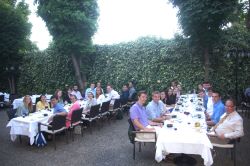 an excellent dinner of lamb or chicken or spinach in sauces that delight the palate. Professor Pana (who was one of the celebrants; I told her she could celebrate, but not count!) and I, having had the dish last night, were able to get a stuffed melon that had a wonderful apricot-flavored sauce that made me want to apply for the vacant job of Sultan of the Ottoman Empire, so I could enjoy similar dishes every night.
an excellent dinner of lamb or chicken or spinach in sauces that delight the palate. Professor Pana (who was one of the celebrants; I told her she could celebrate, but not count!) and I, having had the dish last night, were able to get a stuffed melon that had a wonderful apricot-flavored sauce that made me want to apply for the vacant job of Sultan of the Ottoman Empire, so I could enjoy similar dishes every night.
Start planning your birthday party for Istanbul right now! And be sure to invite me! Please!